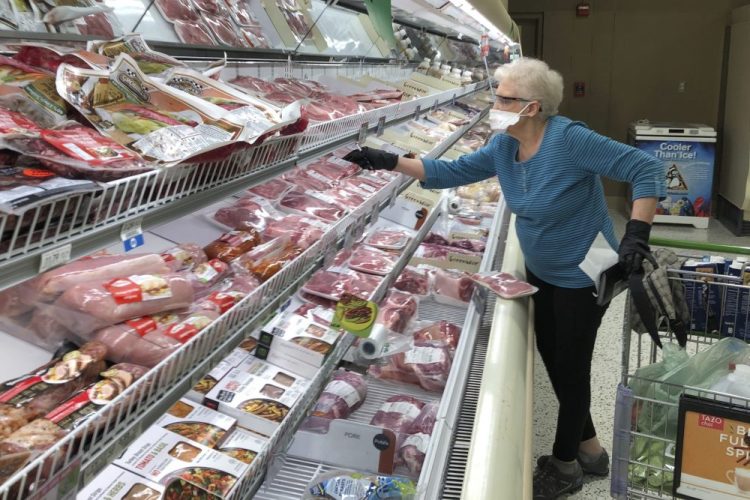The human cost of producing 99-cent chickens and affordable burgers during a pandemic is pushing U.S. meatpackers to eye major operational changes that will likely make American meat more costly.
Some plants are already running slower than normal to adhere to social distancing. But companies are also considering how best to redesign their operations to prevent infections, including by automating some lines altogether. The likely result: higher costs for an industry dominated by the likes of Tyson Foods and JBS that have been very efficient at pumping out cheap meat.
The changes are arriving as concerns mount over mega-plants staffed with low-paid workers operating elbow-to-elbow. More than 10,000 meat workers have been infected by the coronavirus, and at least 30 have died, according to the United Food and Commercial Workers International Union.
In one of Maine’s largest outbreaks, at least 51 cases of COVID-19 have been confirmed at the Tyson Foods plant in Portland.
“Americans want to buy cheaper and cheaper and cheaper food,” said Matthew Wadiak, founder of Cooks Venture, a small chicken producer selling directly to consumers. “We need to figure out how to pay a little bit more, because what’s the cost of a human life? It’s a lot more than 25 cents at the checkout.”
Workers at meatpacking plants continue to fall ill, even with barriers placed between them, more protective equipment and enhanced social-distancing measures in common areas including cafeterias and locker rooms.
While President Trump has ordered plants to reopen, many are running at slower-than-usual rates to try to reduce the spread. Reducing plants to a third of their capacity and distributing the adequate protective equipment could boost chicken prices at grocery stores by 25 percent to 30 percent, according to Sanchoy Das, a professor at the New Jersey Institute of Technology.
“The 99-cents per pound chicken could be in short supply very quickly,” said Das, whose research focuses primarily on supply chain modeling and analysis.
The bulk of America’s beef and pork are processed in a few dozen giant plants that handle thousands of animals in lines that have been allowed to run faster and faster. Tyson, JBS and Cargill control about two-thirds of America’s beef. Pork and chicken production is similarly concentrated.
The outbreak could also help accelerate automation plans companies have already in the works. Tyson has said it is investing “aggressively” in automating the most difficult tasks within its plants. The company is installing robots in the deboning areas of its poultry plants, and also has initiatives in beef and pork.
“You are going to see a bifurcation where the larger, more profitable facilities are going to move toward a vastly more automated meat processing facility,” said Decker Walker, an agribusiness expert at Boston Consulting Group. “Incentives for automation have never been higher.”
Pilgrim’s Pride was increasing its use of automation and robotics even before the pandemic. The company invested more than $30 million in automation last year, projects that are helping plants to run efficiently in the midst of the coronavirus crisis.
“We believe in automation, we believe in robotics, and we’re going to continue to move down that path,” Chief Executive Officer Jayson Penn said in an April 30 call with analysts.
Meat processing is usually a low-margin business, meaning companies will be wary of overspending. While there’s probably going to be a lot of change in the way packers do business, consumers will pay for it in the long run, said Steve Meyer, an economist at consultancy Kerns & Associates.
“This whole system was designed to produce quality products at the most reasonable cost possible, so you don’t go and add a lot of extra cost to go handle a once-in-a-100-year situation,” Meyer said. “But you also don’t turn a blind eye to the fact that people are sick and some people died. So I think there will be some changes made.”
Another way to reduce infections, especially in poultry plants, would be to produce more whole chickens, as cutting up birds into legs and thighs requires more labor, said Das of the New Jersey Institute of Technology.
Consumers in the U.S. can afford to pay a bit more for their meat, said Wadiak of Cooks Venture. That would increase wages and help avoid shared living accommodation, which has been a challenge for meat plant workers looking to adhere to social-distancing practices.
“When the budget is tight, it’s hard to put food on the table, it’s hard to feed your family, I really, really get that,” he said. “But if that means you are putting food on your table at the cost of someone else’s life, it’s not worth it.”
Send questions/comments to the editors.



Success. Please wait for the page to reload. If the page does not reload within 5 seconds, please refresh the page.
Enter your email and password to access comments.
Hi, to comment on stories you must . This profile is in addition to your subscription and website login.
Already have a commenting profile? .
Invalid username/password.
Please check your email to confirm and complete your registration.
Only subscribers are eligible to post comments. Please subscribe or login first for digital access. Here’s why.
Use the form below to reset your password. When you've submitted your account email, we will send an email with a reset code.